
Time Machine rolling ball clock
Review date: 10 June 2004. Last modified 03-Dec-2011.
The standard thing that designers create when they can't think of anything better to design is a chair. Maybe a teapot. Possibly a lamp.
If they're nerds, though, and their reinvented-everyday-item wellspring is dry, they do a clock.
A lot of "designer" clocks are just multi-LCD-display silver-plastic gadgets with bits on. Others take a pretty normal digital or analogue clock face and put it in some novel object or other. Others, though, try to redefine the whole concept of timekeeping as we know it, and as a result often end up being as nifty and illegible as the more exotic Japanese wristwatches.
Timepieces like this are, usually, exercises in engineering perversity; an obfuscated code contest in the real world. Some may be easy to read if you know the trick; others may remain pretty obscure (though I suppose that one could be worse).
And then, there's this.
It's called the Time Machine. It's made (well, currently licensed, at least; Time Machines have been on sale since at least the late 1970s) by Can You Imagine (incidentally, they also make the Airzooka), and it's a clock. A "ball clock", to be exact; it displays the time with rows of shiny steel ball bearings, which line up with numbers.
Ball clocks are one of the less loopy oddball timepieces out there. They're actually pretty legible, for a start; the Time Machine has a ball-row for hours (1 to 12), five-minutes (zero to 55) and single minutes (zero to 4). It's not quite as one-glance legible as a standard digital or analogue clock, but adding the numbers from bottom to top isn't very difficult.
Here it is without its clear plastic lid on. It's reading 9:53 and 30 seconds; the seconds are displayed on the dial at the top back of the clock.
How's it work? Glad you asked.
The whole contraption's powered by four C batteries. There's a barrel socket for an optional six volt AC adapter, too.
Every minute, this arm rotates. Fancy ball clocks apparently have an arm that turns slowly all the time; the Time Machine's arm only takes about ten seconds to rotate, and spends the rest of the minute stationary.
At the start of its rotation, the arm collects one ball from the end of the return trough at the bottom of the clock. This makes a noise eerily reminiscent of a CD-ROM drive tray opening.
At the top of its rotation, the arm drops the ball off into a trough that leads to the top, minutes, row. In this picture, the minutes row reads 2 at the moment, and will read 3 when the new ball arrives.
The rotation time of the arm means that the clock indicates the minute several seconds after the minute actually passes; some attempt seems to have been made to sync the ball delivery to the actual zero seconds mark, but it's not accurate. You're not timing the Olympic hundred metres with this thing, though. It'll do.
If the minutes row already has four balls in it when the new one arrives...
...it overbalances and tips all of the balls out, as represented in this cunningly staged picture (which is why the ball delivery arm is still vertical - it would have turned a bit further by now if the clock were actually running).
The fifth ball never actually makes it into the display portion of the minutes row. This is important, because the four balls that were already there get dumped into a run that leads to a downpipe and the return trough. The fifth ball drops into a parallel run that leads to the five-minute row. It is, after all, a ball that indicates the fifth minute; it should go to the five-minute row.
The five-minute and hour rows both hold 12 balls, but otherwise they work in the same way as the minute row. Balls trickle in until the five-minute row fills, then it dumps one ball into the hour row, and the rest into the return chute. The hour row fills up, then dumps everything into the return chute. And the song goes on.
(An extended version of the clock could have a little AM/PM row under the hour row, and a day row under that, and months under that, and so on. Dealing with months of different lengths, and leap years, is left as an exercise for the reader.)
To make all this work, all three rows need a constant counterweight to hold them up until the last ball arrives. The counterweights are three un-moving, permanent balls, in addition to all of the rolling ones. The smallest number the hour tray should ever display is 1, so it's got a silver counterweight ball, the same as the rolling ones, in the 1 position. The minute and five-minute displays need to be able to display zero, so they have inconspicuous black counterweight balls that don't line up with a number.
The five-minute row actually has its own little separate downpipe that leads to a sort of on-ramp to the dump trough for the hour row. To prevent traffic jams, the dumped five-minute balls are stopped by this flip-up barrier, which is moved out of the way by the other end of the rotating arm, shortly after it's picked up a ball over on the other side of the clock. Because this happens before the ball gets dropped, the blocked five-minute balls actually finish their trip to the return chute when the arm starts rotating for the next minute.
More thoughtful readers will, by now, have realised that this clock makes a bit of noise every minute, a bit more noise every five minutes, quite a bit of noise every hour, and frankly quite a racket at one AM and one PM, when all three trays get dumped.
This is true; the Time Machine would be an interesting candidate for tick analysis. It isn't terribly loud, especially with its cover on, but if all of your interior doors are open, you still won't have any trouble hearing it "chiming" through the whole of an average house, if nothing else is going on.
You probably wouldn't want to use it as a bedside clock.
Run time
When it's running but the arm isn't moving, the Time Machine draws between 1 and 1.5 milliamps (mA) out of its batteries; 1.25mA, say. The arm takes about ten seconds to rotate, and draws an average of 10mA while it's doing it. So, every minute, there's a total draw of something like 162.5 milliamp-seconds (mAs) of energy from fresh batteries. Every hour, 9750mAs; every day, 234,000mAs.
There are 3600 milliamp-seconds in a milliamp-hour (mAh), so that's 65mAh a day. If your wristwatch needed 65mAh at six volts every day to run then it'd kill its batteries in a day, at most, but C cells are made of much sterner stuff (PDF datasheet here). Consumer C alkalines these days have a capacity of more than 8000mAh into a much heavier load than the Time Machine presents, but doing the straight arithmetic from that number suggests that you'll only get about a third of a year of operation out of a set of batteries.
Actually, I think they'll last a great deal longer than that; the Time Machine still ticked over when my bench supply was wound down to less than three volts. The arm still turned, drawing only a few milliamps; it turned slower, but that didn't matter, since the timekeeping function is in the ticking dial, which still worked fine. So I wouldn't be surprised if you got a year of life out of every set of batteries.
Using it
Setting the Time Machine isn't hard. It comes with an instruction sheet that makes it simple. You put the counterweight balls in place, you load the rows appropriately, you dump the rest of the balls into the return chute, and you're done.
I've had the Time Machine clunking away on the workbench in my office for some weeks now. Its sound was initially mildly annoying, but I've come to find it quite soothing, now, and the noise it makes is a good reminder of what time it is. Lots of balls dumping to indicate an hour is better than waiting for a grandfather clock to go bong, if you ask me.
It seems to keep good time, too. Maybe off by a second or three a week, but that's no big deal; it's easy enough to correct the clock if you find it wandering significantly, and it's unquestionably one of the world's easiest clocks to reset at the start and end of daylight saving time. As long as it's sitting on a reasonably level surface, the Time Machine works very reliably.
A couple of times, I've walked into the office to find the Time Machine running substantially slow...
...but I am unconvinced that any mechanical defect is responsible.
Inside
The Time Machine is not exactly Swiss-made. It's held together with little black screws, which you should take care removing; the plastic the clock's made from is quite fragile. There's still some reason, beyond mere curiosity, to take a Time Machine apart; to replace a worn-out motor some years down the track, for instance.
Here's the motor in question, at the end of the simple reduction gearbox that turns the ball-moving arm. A microswitch under the last gear is pressed by a cam when the arm's in the vertical position...
...and this simple little circuit board ties together the motor, the position switch, and the clock module.
The board's typical of the circuitry in various cheap Chinese-made gadgets. A correspondent's told me that his Time Machine had a badly made circuit board replete with highly questionable solder joints, but this one looks OK to me.
Here's the back of the clock module. It's a stripped-back version of an ordinary quartz wall clock movement, which accounts for that oh-so-classy empty AA battery bay at the bottom.
Buying one
My review Time Machine came from Edmund Scientific's "Scientifics Online", who sell it for a pretty-much-on-par $US49.95, ex shipping. They don't currently ship outside the USA, though.
There are other places that sell Time Machines for the same price or more; you may be able to save a bit if you shop around. The only cheaper dealer I found when I looked, though, was Amazon.com, who have translucent green, blue and orange UV-glow versions of the Time Machine (Edmund sell the blue one, too) for only $US29.99.
Except, as I write this, Amazon don't actually have any Time Machines to sell. Edmund do.
Overall
Is the Time Machine a practical timekeeping device? Well, not in objective terms, no. But it's a lot more practical than you'd think, and it works well, and it's quite easy to read, and it's a fascinating thing to watch.
Yes, telling time in this way is a bit like the measuring-a-building-with-a-barometer joke, but if you ask me, getting this good a combination of timepiece, sculpture and gadget for only $US50-odd is something of a bargain.
Recommended.
Review Time Machine kindly provided by Scientifics Online.
UPDATE: Apparently the original version of this clock was made
out of wood, so it looked a lot classier, probably sounded nicer too, and was of course
also much more expensive.
You can now buy that version again, from "Idle-Tyme".
Expect to pay at least $US230 plus
shipping, though.
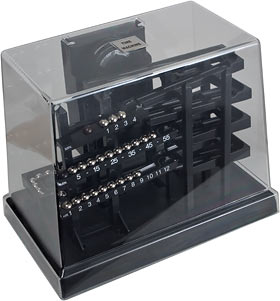


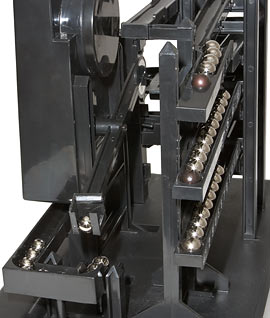
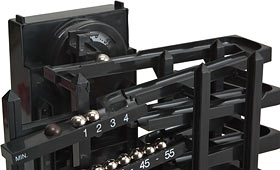

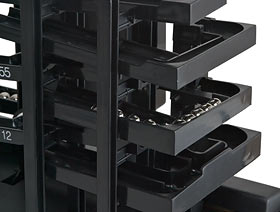
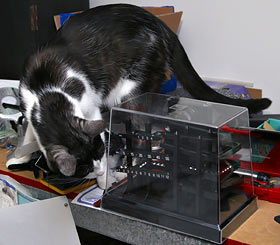
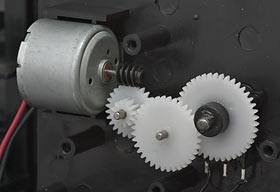

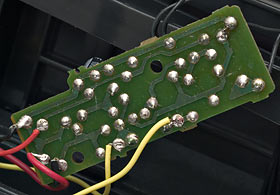
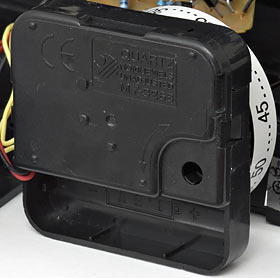
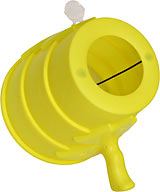

![[SecureWebs]](images/sw.gif)